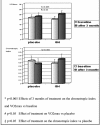The GH/IGF-1 Axis and Heart Failure
- PMID: 20676279
- PMCID: PMC2822143
- DOI: 10.2174/157340309788970306
The GH/IGF-1 Axis and Heart Failure
Abstract
The growth hormone (GH)/insulin-like growth factor 1 (IGF-1) axis regulates cardiac growth, stimulates myocardial contractility and influences the vascular system. The GH/IGF-1 axis controls intrinsic cardiac contractility by enhancing the intracellular calcium availability and regulating expression of contractile proteins; stimulates cardiac growth, by increasing protein synthesis; modifies systemic vascular resistance, by activating the nitric oxide system and regulating non-endothelial-dependent actions. The relationship between the GH/IGF-1 axis and the cardiovascular system has been extensively demonstrated in numerous experimental studies and confirmed by the cardiac derangements secondary to both GH excess and deficiency. Several years ago, a clinical non-blinded study showed, in seven patients with idiopathic dilated cardiomyopathy and chronic heart failure (CHF), a significant improvement in cardiac function and structure after three months of treatment with recombinant GH plus standard therapy for heart failure. More recent studies, including a small double-blind placebo-controlled study on GH effects on exercise tolerance and cardiopulmonary performance, have shown that GH benefits patients with CHF secondary to both ischemic and idiopathic dilated cardiomyopathy. However, conflicting results emerge from other placebo-controlled trials. These discordant findings may be explained by the degree of CHF-associated GH resistance. In conclusion, we believe that more clinical and experimental studies are necessary to exactly understand the mechanisms that determine the variable sensitivity to GH and its positive effects in the failing heart.
Keywords: Acromegaly; Chronic heart failure; GH deficiency.; GH/IGF-1 axis.
Figures


Similar articles
-
The GH/IGF-1 axis in chronic heart failure.Endocr Metab Immune Disord Drug Targets. 2013 Mar;13(1):76-91. doi: 10.2174/1871530311313010010. Endocr Metab Immune Disord Drug Targets. 2013. PMID: 23369140 Review.
-
Role of growth hormone in chronic heart failure: therapeutic implications.Ital Heart J. 2000 Nov;1(11):732-8. Ital Heart J. 2000. PMID: 11110515 Review.
-
Role of growth hormone in chronic heart failure. Therapeutic implications.Drugs. 2000 Oct;60(4):711-9. doi: 10.2165/00003495-200060040-00002. Drugs. 2000. PMID: 11085197 Review.
-
Growth hormone, acromegaly, and heart failure: an intricate triangulation.Clin Endocrinol (Oxf). 2003 Dec;59(6):660-71. doi: 10.1046/j.1365-2265.2003.01780.x. Clin Endocrinol (Oxf). 2003. PMID: 14974906 Review.
-
Recombinant human growth hormone treatment for dilated cardiomyopathy in children.Pediatrics. 2004 Oct;114(4):e452-8. doi: 10.1542/peds.2004-0072. Pediatrics. 2004. PMID: 15466071 Clinical Trial.
Cited by
-
The IGF-1R Inhibitor NVP-AEW541 Causes Insulin-Independent and Reversible Cardiac Contractile Dysfunction.Biomedicines. 2022 Aug 19;10(8):2022. doi: 10.3390/biomedicines10082022. Biomedicines. 2022. PMID: 36009569 Free PMC article.
-
The Biology of Physiological Health.Cell. 2020 Apr 16;181(2):250-269. doi: 10.1016/j.cell.2020.03.036. Cell. 2020. PMID: 32302569 Free PMC article. Review.
-
Diastolic Dysfunction with Normal Ejection Fraction and Reduced Heart Rate in Mice Expressing Human Growth Hormone and Displaying Signs of Growth Hormone Insufficiency.Int J Mol Sci. 2024 Dec 31;26(1):269. doi: 10.3390/ijms26010269. Int J Mol Sci. 2024. PMID: 39796124 Free PMC article.
-
Association between insulin-like growth factor-1 and cardiovascular events: a systematic review and dose-response meta-analysis of cohort studies.J Endocrinol Invest. 2022 Dec;45(12):2221-2231. doi: 10.1007/s40618-022-01819-1. Epub 2022 May 21. J Endocrinol Invest. 2022. PMID: 35596917
-
Left Heart Dysfunction in Acromegaly Revealed by Novel Echocardiographic Methods.Front Endocrinol (Lausanne). 2020 Jun 24;11:418. doi: 10.3389/fendo.2020.00418. eCollection 2020. Front Endocrinol (Lausanne). 2020. PMID: 32670201 Free PMC article.
References
-
- Duello TM, Halmi NS. Ultrastructural-immunocytochemical localization of growth hormone and prolactin in human pituitaries. J Clin Endocrinol Metab. 1979;49:189–96. - PubMed
-
- Thorner MO, Vance ML, Horvath E, Kovacs K. In: Textbook of Endocrinology. The anterior pituitary. Wilson JD, Foster DW, editors. Philadelphia: WB Saunders Co; 1992. pp. 221–310.
-
- Tannenbaum GS, Ling N. The interrelationship of growth hormone (GH)-releasing factor and somatostatin in generation of the ultradian rhythm of GH secretion. Endocrinology. 1984;115:1952–7. - PubMed
-
- Plotsky PM, Vale W. Patterns of growth hormone-releasing factor and somatostatin secretion into the hypophyseal-portal circulation of the rat. Science. 1985;230:461–3. - PubMed
-
- Arce V, Lima L, Lois N, et al. Role of central dopaminergic pathways in the neural control of growth hormone secretion in normal men: studies with metoclopramide. Neuroendocrinology. 1991;53:143–9. - PubMed
LinkOut - more resources
Full Text Sources
Miscellaneous

